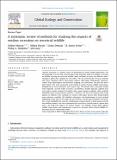A systematic review of methods for studying the impacts of outdoor recreation on terrestrial wildlife
Abstract
Outdoor recreation is a known source of disturbance to many wildlife populations. We systematically reviewed 126 relevant papers that study the impact of outdoor recreation on wildlife, focusing on terrestrial wildlife (birds excluded) to assess the different methodological approaches adopted by researchers. We characterised the research methods into seven categories (direct observation, indirect observation (field-based), telemetry, camera traps, physiological measurement, trapping, and simulation). We find that direct observation is the most commonly used method to capture human-wildlife interactions, followed by the use of telemetry, and camera traps. The animals most commonly studied were ungulates, and the orders Carnivora and Rodentia. Studies typically captured data over longer periods (median 54 months) when using trapping methods; other methods exhibited shorter study durations (median 22 months). The size of the animal under study appears to influence how methods are chosen, with larger species often being studied using telemetry methods. We highlight advantages and disadvantages of each method depending on the aims of the study, the focal species, and the type of outdoor recreation. Our review highlights the need for simultaneous measurements of both human activity and wildlife response. We also recommend that researchers consider how to capture both short- and long-term impacts on animal welfare. Our findings should guide applied wildlife conservation and management research in scenarios where human-wildlife interactions lead to conservation issues.
Citation
Marion , S , Davies , A , Demsar , U , Irvine , J , Stephens , P & Long , J 2020 , ' A systematic review of methods for studying the impacts of outdoor recreation on terrestrial wildlife ' , Global Ecology and Conservation , vol. 22 , e00917 . https://doi.org/10.1016/j.gecco.2020.e00917
Publication
Global Ecology and Conservation
Status
Peer reviewed
ISSN
2351-9894Type
Journal item
Description
This project would not have been possible without the support from the Carnegie Trust, a James Hutton Institute – University of St Andrews collaborative PhD Studentship.Collections
Items in the St Andrews Research Repository are protected by copyright, with all rights reserved, unless otherwise indicated.

